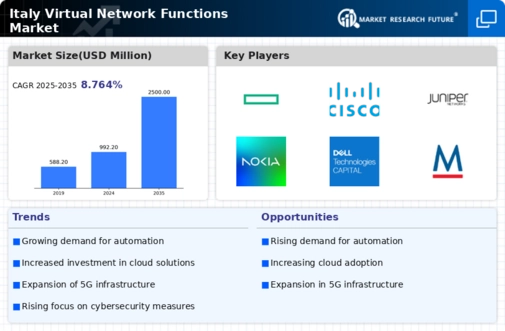Rising Demand for Network Flexibility
The virtual network-functions market in Italy is experiencing a notable surge in demand for network flexibility. Businesses are increasingly seeking solutions that allow for rapid deployment and scalability of network services. This shift is driven by the need for organizations to adapt to changing market conditions and customer requirements. According to recent data, the Italian telecommunications sector has reported a growth rate of approximately 15% in the adoption of virtual network functions, indicating a strong trend towards flexible network architectures. As companies strive to enhance operational efficiency, the virtual network-functions market is positioned to benefit significantly from this demand for adaptable networking solutions.
Technological Advancements in Networking
Technological advancements play a pivotal role in shaping the virtual network-functions market in Italy. Innovations such as 5G technology and edge computing are driving the evolution of networking solutions. The integration of these technologies enables enhanced performance, lower latency, and improved user experiences. As Italian telecom operators invest in next-generation infrastructure, the demand for virtual network functions is expected to rise. Industry expert's indicate that the market could witness a growth rate of around 20% over the next few years, fueled by the ongoing technological transformation within the telecommunications landscape.
Cost Efficiency and Resource Optimization
Cost efficiency remains a critical driver for the virtual network-functions market in Italy. Organizations are increasingly recognizing the financial benefits associated with transitioning from traditional hardware-based networking to virtualized solutions. By leveraging virtual network functions, companies can reduce capital expenditures and operational costs. Reports suggest that businesses in Italy have achieved cost savings of up to 30% by implementing virtual network functions, which allows for better allocation of resources. This trend is likely to continue as more enterprises seek to optimize their IT budgets while maintaining high-quality network services, further propelling the growth of the virtual network-functions market.
Growing Focus on Enhanced Customer Experience
The virtual network-functions market in Italy is increasingly influenced by the growing focus on enhanced customer experience. Businesses are recognizing that delivering superior service quality is essential for retaining customers in a competitive landscape. Virtual network functions enable service providers to offer personalized and responsive services, thereby improving customer satisfaction. Data indicates that companies utilizing virtual network functions have reported a 25% increase in customer retention rates. As organizations prioritize customer-centric strategies, the demand for virtual network functions is likely to rise, driving further growth in the market.
Regulatory Support for Digital Transformation
Regulatory support is emerging as a significant driver for the virtual network-functions market in Italy. The Italian government has been actively promoting digital transformation initiatives, which include the adoption of advanced networking technologies. Policies aimed at enhancing broadband connectivity and fostering innovation are likely to create a conducive environment for the growth of virtual network functions. As regulatory frameworks evolve to support digital infrastructure, the virtual network-functions market is expected to gain momentum. This supportive landscape may lead to increased investments in virtual networking solutions, further solidifying their role in the telecommunications sector.






















Leave a Comment